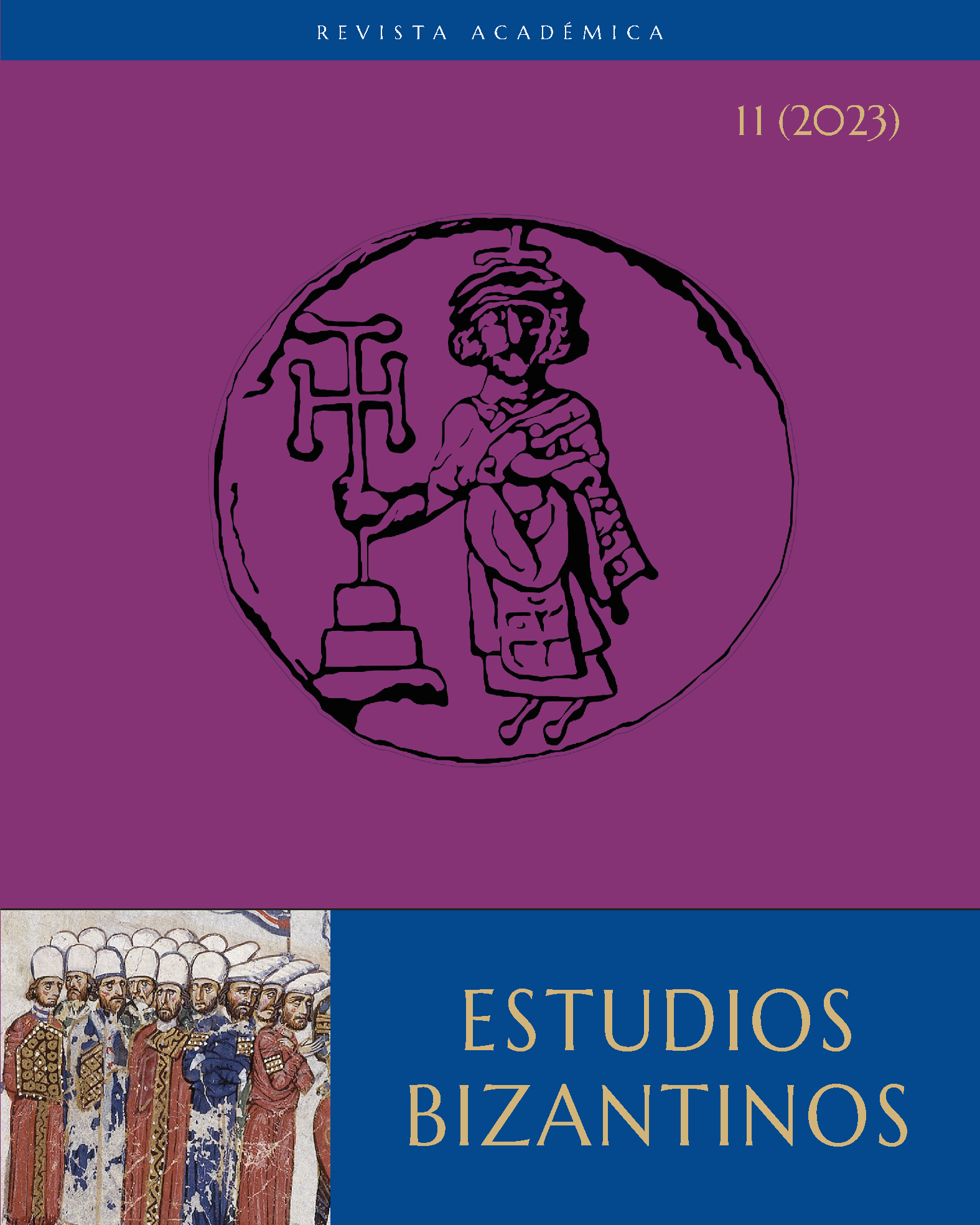Aphrodite and the sea within John of Gaza’s Tabula Mundi
DOI:
https://doi.org/10.37536/ebizantinos.2023.11.2390Keywords:
John of Gaza, Tabula Mundi, Aphrodite, Sea, NeoplatonismAbstract
This article focuses on a passage of John of Gaza’s Tabula Mundi, i.e. the one regarding Aphrodite and the Sea (vv. 454-466), which raises an exegetical problem. Generally, scholars tend to assume that they are the same figure. On the contrary, I argue that they are two different figures, making reference to the cultural context of the poem, especially to its philosophical background. Indeed, in a Neoplatonic perspective the goddess can be interpreted as the Soul that triumphs over the matter, i.e. the sea, since they are both represented shining bright and staring at the sunlight, i.e. the Intellect. This interpretation is confirmed by references to Aphrodite in Neoplatonic authors as well as in John’s Anacreontics and in the authors of the so-called “school of Gaza”, strongly influenced by Neoplatonism. Therefore, John wants to emphasize the triumph of the light and, ultimately, of the One/God, through the mystical vision of a late antique intellectual, in a definitely syncretistic context.
Downloads
References
Abbate, M. 2017, Proclo. Commento al Cratilo di Platone, Milano.
Aleksandrova, T. 2020, “The Syncretic Revelation of John of Gaza”, Scrinium 16, 147-157.
Bargellini, F. 2008, “Questioni di cronologia nell’opera di Giovanni di Gaza”, Prometheus 34, 65-86.
Cameron, A. 1993, “On the Date of John of Gaza”, CQ 43, 348-351.
Champion, M. W. 2014, Explaining the Cosmos: Creation and Cultural Interaction in Late-Antique Gaza, Oxford.
Ciccolella, F. 2000 (ed.), Cinque poeti bizantini. Anacreontee dal Barberiniano greco 310, Alessandria.
Cupane, C. 1979, “Il Kosmikos Pinax di Giovanni di Gaza: una proposta di ricostruzione”, JÖB 28, 195-207.
Downey, G. 1963, Gaza in the Early Sixth Century, Norman.
Faggin, G. 2000 (ed.), Plotino. Enneadi, Milano.
Gigli Piccardi, D. 2005, “ΑΕΡΟΒΑΤΕΙΝ. L’ecfrasi come viaggio in Giovanni di Gaza”, MEG 5, 181-199.
Gigli Piccardi, D. 2006, “L’occasione della Tabula Mundi di Giovanni di Gaza”, Prometheus 32, 253-266.
Gigli Piccardi, D. 2011, “John of Gaza and the Greek Ekphrastic Poetry”, in D. Hernández de la Fuente (ed.), New Perspectives on Late Antiquity, Newcastle, 288-304.
Gigli Piccardi, D. 2014, “Poetic Inspiration in John of Gaza: Emotional Upheaval and Ecstasy in a Neoplatonic Poet”, in K. Spanoudakis (ed.), Nonnus of Panopolis in Context. Poetry and Cultural Milieu in Late Antiquity with a Section on Nonnus and the Modern World, Leiden-Boston, 403-419.
Gigli Piccardi, D. 2018, “La quinta anacreontea di Giovanni di Gaza: una lezione sul mito”, Prometheus 44, 267-279.
Gigli Piccardi, D. 2021, Giovanni di Gaza. Tabula mundi, Alessandria.
Giordano D. 2022 (ed.), Proclo. Inni, Milano.
Lauritzen, D. 2015, Jean de Gaza. Description du Tableau Cosmique, Paris.
Leader-Newby, R. 2005, Personifications and paideia in Late Antique Mosaics from the Greek East, in E. Stafford – J. Herrin (eds.), Personification in the Greek World. From Antiquity to Byzantium, London, 231-246.
Lupi, S. 2012, “Il mito di Afrodite ed Adone alla scuola di retorica di Gaza”, Revue des études anciennes 114, 83-100.
Maguire, H. 1987, Earth and Ocean. The Terrestrial World in Early Byzantine Art, University Park and London.
Maguire, H. 1993, “Christians, Pagans and the Representation of Nature”, in D. Willers et alii (eds.), Begegnung von Heidentum und Christentum im spätantiken Ägypten, Riggisberg, 131-160.
Penella, R. J. 2020, “The Rhetorical Works of the School of Gaza”, BZ 113, 111-174.
Renaut, L. 1999, “La description d’une croix cosmique par Jean de Gaza, poète palestinien du VIe siècle”, Civilisation Médiévale 7, 211-220.
Simonini, L. 1986, Porfirio. L’antro delle Ninfe, traduzione e commento di L. Simonini, Milano.
Siorvanes, L. 2005, Neo-Platonic Personification, in E. Stafford – J. Herrin (eds.), Personification in the Greek World. From Antiquity to Byzantium, London, 77-96.
Stafford, E. 2000, Worshipping Virtues. Personification and the Divine in Ancient Greece, London.
Stafford E./Herrin J. 2005 (eds.), Personification in the Greek World. From Antiquity to Byzantium, London.
Tissi, L. M. 2012, “La conversione di Bythos in Giovanni di Gaza”, Prometheus 38, 255-272.
Van Dam, R. 1985, “From Paganism to Christianity at Late Antique Gaza”, Viator 16, 1-20.
Downloads
Published
How to Cite
Issue
Section
License
Copyright (c) 2023 Arianna Magnolo

This work is licensed under a Creative Commons Attribution-NonCommercial-ShareAlike 4.0 International License.
You are free to:
- Share — copy and redistribute the material in any medium or format
- Adapt — remix, transform, and build upon the material
Under the following terms:
-
Attribution — You must give appropriate credit, provide a link to the license, and indicate if changes were made. You may do so in any reasonable manner, but not in any way that suggests the licensor endorses you or your use.
-
NonCommercial — You may not use the material for commercial purposes.
-
ShareAlike — If you remix, transform, or build upon the material, you must distribute your contributions under the same license as the original.
-




